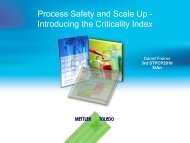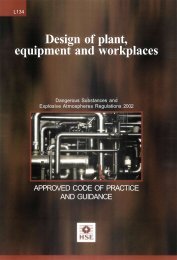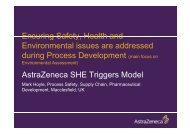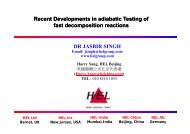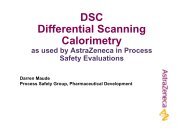Designing and operating safe chemical reaction processes HSG143
Designing and operating safe chemical reaction processes HSG143
Designing and operating safe chemical reaction processes HSG143
Create successful ePaper yourself
Turn your PDF publications into a flip-book with our unique Google optimized e-Paper software.
Health <strong>and</strong> SafetyExecutiveProtective measures146 Protective measures mitigate the consequences of a hazard. They are rarelyused on their own. Some preventive measures are usually present to reduce thedem<strong>and</strong> on the protective system. Protective measures include:(a) containment within the reactor system;(b) emergency pressure relief or venting, <strong>and</strong> dumping;(c) crash cooling;(d) <strong>reaction</strong> inhibition;(e) drown-out <strong>and</strong> quenching; <strong>and</strong>(f) secondary containment.147 All the protective measures, with the exception of containment <strong>and</strong> venting,normally rely on a control system to operate them. Therefore, the <strong>safe</strong>ty integrityof the protective measure <strong>and</strong> the integrity of the control system 17,18 are bothimportant in its selection.148 As with all other aspects of <strong>safe</strong> <strong>chemical</strong> <strong>processes</strong>, it is important thatthe design of any protective measure is adequate. For this to happen you mustunderst<strong>and</strong> the runaway <strong>reaction</strong> process in detail. An undersized vent on a reactorwill not totally protect the reactor against damage. As the protective measure is thelast line of defence, it needs designing to protect against the worst case scenario.Assessing the worst case scenario149 The worst case scenario is the one in which a credible combination ofequipment failures <strong>and</strong> process maloperations occur which places the highestdem<strong>and</strong> on the protective system. It therefore depends on the basis of <strong>safe</strong>tychosen.150 For example, if emergency relief is the chosen basis of <strong>safe</strong>ty then the worstcase scenario is that which results in the largest vent area being required to protectthe reactor. If the basis of <strong>safe</strong>ty is to be containment then the worst case scenariois that which results in the highest final pressure <strong>and</strong> temperature.151 The information you need to characterise the worst case scenario will varywith the protective measure selected. It may include:(a) the worst rate of heat production at runaway;(b) the worst rate of gas evolution <strong>and</strong> pressure development at runaway; <strong>and</strong>(c) the maximum pressure <strong>and</strong> temperature developed in a closed vessel when arunaway occurs.152 The problems associated with measuring heat generation <strong>and</strong> heat lossdescribed previously also apply to the worst case scenario. For realistic simulationof the <strong>reaction</strong> under runaway conditions you need to measure these parametersusing an adiabatic calorimeter with low thermal mass.Containment within the reactor153 In this case the design of the reactor system should withst<strong>and</strong> the maximumpressure generated by the runaway <strong>reaction</strong>.<strong>Designing</strong> <strong>and</strong> <strong>operating</strong> <strong>safe</strong> <strong>chemical</strong> <strong>reaction</strong> <strong>processes</strong> Page 30 of 64





